
What is Ephesus?
Some of the best ancient Greek and Roman ruins aren’t in Greece or Rome at all. The Greco-Roman empire stretched across Europe, over western Asia, and into northern Africa, so I shouldn’t have been so surprised to arrive in western Turkey and learn that one of the region’s top tourist attractions is Ephesus, Turkey: the site of a vast city dating back over 2,000 years.
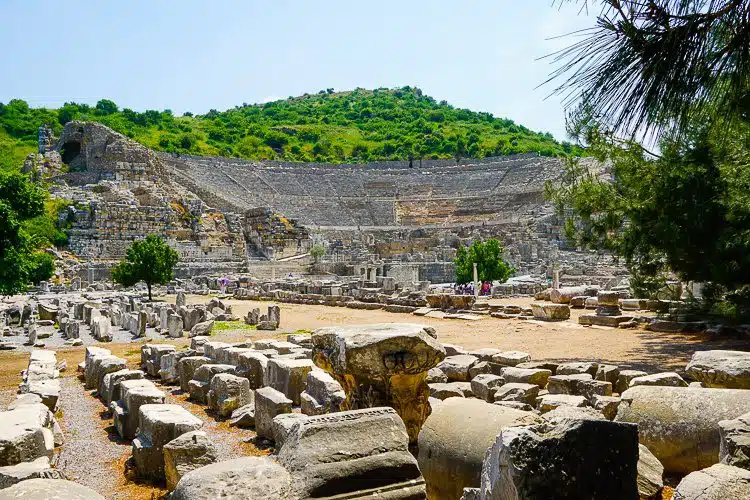
Visiting Ephesus: Hands On!
There is a reason that tourists from around the world flock to Ephesus, Turkey. Touring the ruins provides an entire day of gasp-inducing vistas, notable history, and architectural delights. What particularly shocked me was how hands-on the archeological site is.
Visitors are allowed to caress, jump on, and dance atop many of the ancient structures, despite the age and fame of the stones. You can literally walk in the footsteps of ancient Greeks and Romans!
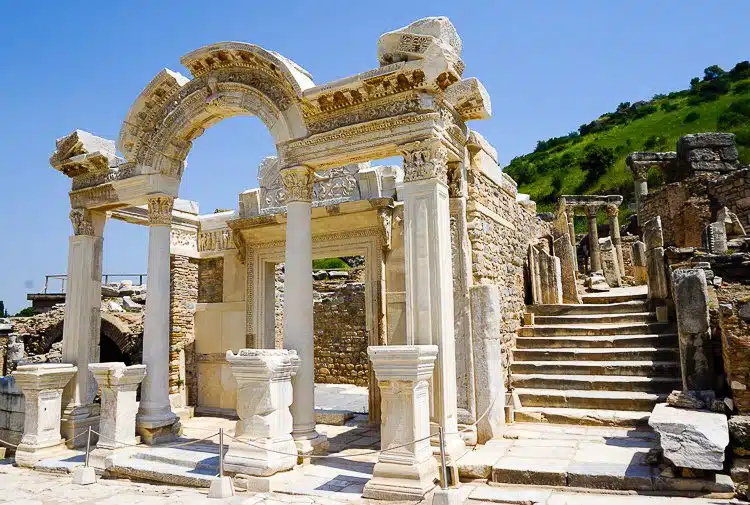
Where is Ephesus, Turkey?
The other fabulous part of Ephesus is its location. Nestled amid soft green hills dotted with wildflowers, the ancient columns resemble a movie set. The Aegean Sea used to lap right up against the city (how pretty that must have been!), but the waters have since receded due to ancient deforestation and erosion.
There is still swimming nearby, however. Just a 24-minute drive away is Kusadasi: a town with a sparkling azure beach which boasts lovely accommodations, such as the waterfront hotel in which we stayed. Driving, Ephesus, Turkey is about 6.5 hours from Istanbul. To reach this region via air, the flight from Istanbul is just over an hour.
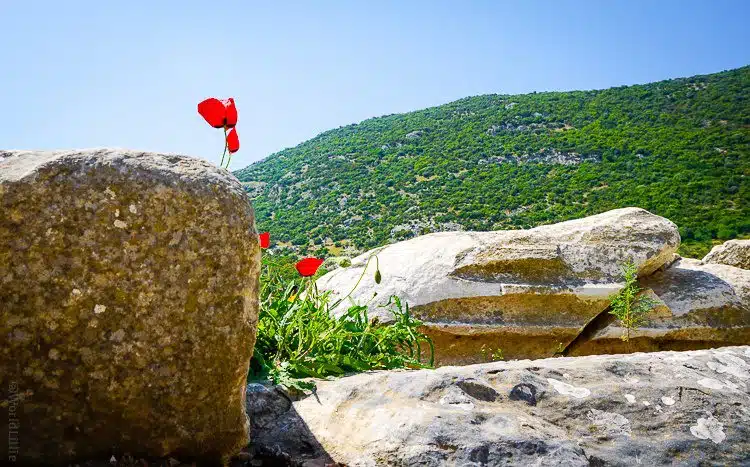
The long history of Ephesus
Humans first began settling the area over 8,000 years ago, and the actual city was founded — according to legend — around 1000 BCE, when a prince from Athens named Androklos followed the Oracle of Delphi‘s instructions to “let the fish and boar show you the way.” (I’m imagining these all-knowing animals in fancy clothes, singing and pointing as the Greek prince followed dutifully behind…)
A second legend about the founding of Ephesus is even more exciting, though less substantiated: It was created by Amazon warrior women, spearheaded by their queen, Ephos!
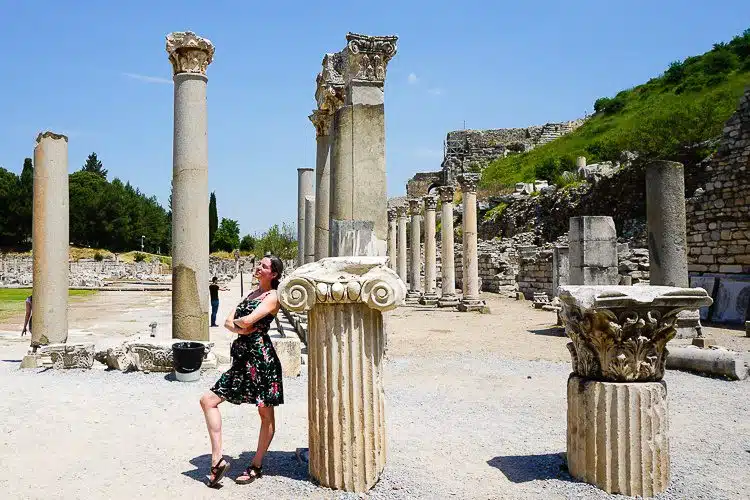
Temple of Artemis: One of the 7 Wonders of the Ancient World!
It turns out that one of them, the Temple of Artemis, considered one of the Seven Wonders of the Ancient World, was located in Ephesus! The temple was rebuilt three times (the third time under the direction of Alexander the Great, whose birth coincided with the destruction of the second temple by arson) before being almost completely demolished in 401 CE.
2,000 years ago during the heyday of the temple, the creator of the Seven Wonders named Antipater of Sidon, gushed: “I have set eyes on the wall of lofty Babylon […] and the status of Zeus by the Alpheus, and the hanging gardens, and the colossus of the Sun, and the huge labour of the high pyramids, and the vast tomb of Mausolus; but when I saw the house of Artemis that mounted to the clouds, those other marvels lost their brilliancy, and I said, ‘Lo, apart from Olympus, the Sun never looked on aught so grand.'”
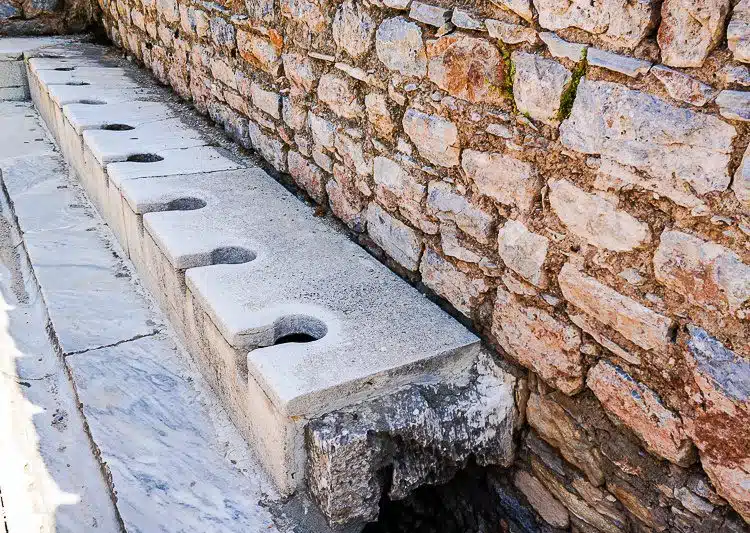
Ancient toilets of Ephesus, Turkey…
Though almost nothing remains of that temple, many other wonders of Ephesus remain… such as its remarkable ancient public toilets! As you can see by the photo above, visitors can actually sit on these marble latrines, though please do not pull your pants down and do your business therein.
Ancient Ephesians using these 36 holes could enjoy a flowing stream of water near their feet into which they could dip a sponge on a stick that they’d use to wipe their bottoms. Since the stone of the thrones could get chilly in winter, rich citizens sometimes had their minions sit on the potty to warm it before they arrived!
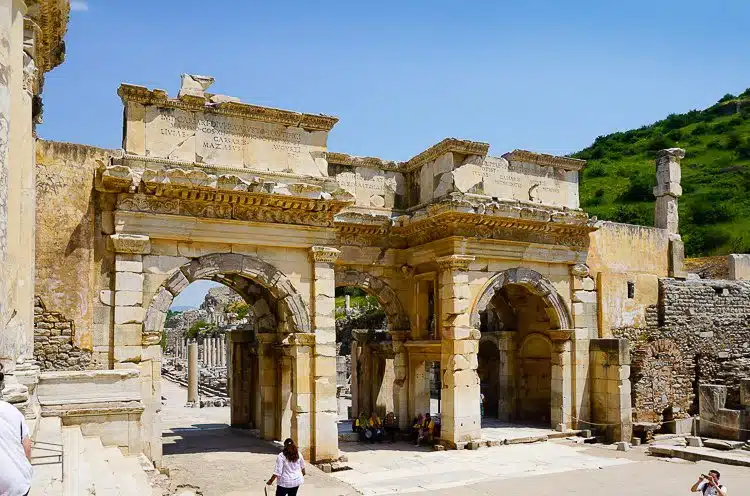
What about gender equality in Ephesus?
Women’s rights flourished in the city, partly because of the cult of the goddess Artemis. Ephesus changed hands numerous times after its founding (Persian, Egyptian, then Greek again), and in 133 BCE, became part of the Roman Empire.
How many people lived in Ephesus during that time period?
Emperor Augustus named Ephesus the capital of preconsular Asia in 27 BCE, and the city flourished. The historian Strabo declared the city was only second to Rome in importance and size.
Current estimates put the population at 56,000 people, though other calculations posit much higher. Why, the Great Theater alone could hold 25,000 spectators, and is theorized to be the largest outdoor theater in the ancient world! Good thing Ephesus had one of the most high-tech sewer and aqueduct systems of the time to support all its humans…
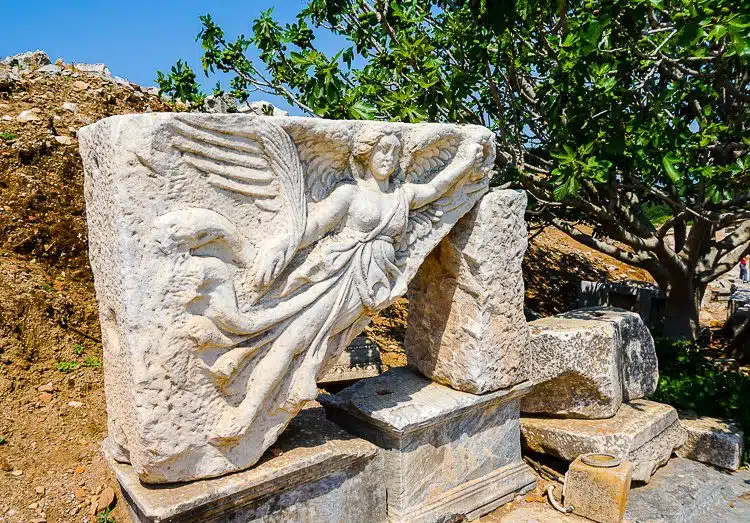
The fall of Ephesus…
Alas, the decline of Ephesus began in 263 CE when Goths attacked, destroying the city. An earthquake smashed buildings in the year 614, and Arabs pillaged in both the mid 600s and 700s. The once grand metropolis reverted to a quiet village, eventually becoming integrated into the Ottoman Empire.
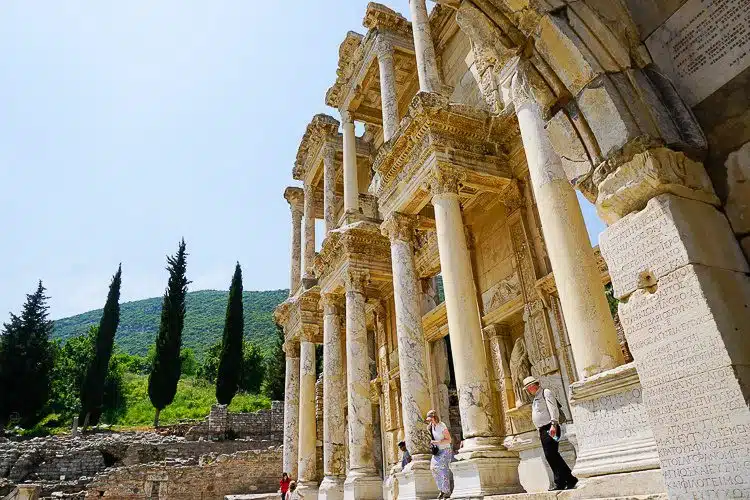
When was Ephesus discovered by archeologists?
Archaeologists began excavating Ephesus in 1863, and it is now one of the biggest Roman archaeological sites of the eastern Mediterranean. We have these intrepid workers to thank for reconstructing many of the buildings that make Ephesus, Turkey so notable, most famously, the breathtaking facade of the Library of Celsus, pictured above and in the first photo of this article.

Bible connections in Turkey:
In addition to its architectural and historical importance, did you know that Ephesus is known for its Biblical connections? The apostle Paul lived in Ephesus in the 50s CE, stories say the Seven Sleepers slumbered there for centuries, the Gospel of John may have been written in the city, and Ephesus is discussed in the Book of Revelations.
Further, many think that Mary, Biblical mother of Jesus, spent her final days in the small house near Ephesus — a site that I found particularly moving and peaceful to visit, though I come from a different religious background.
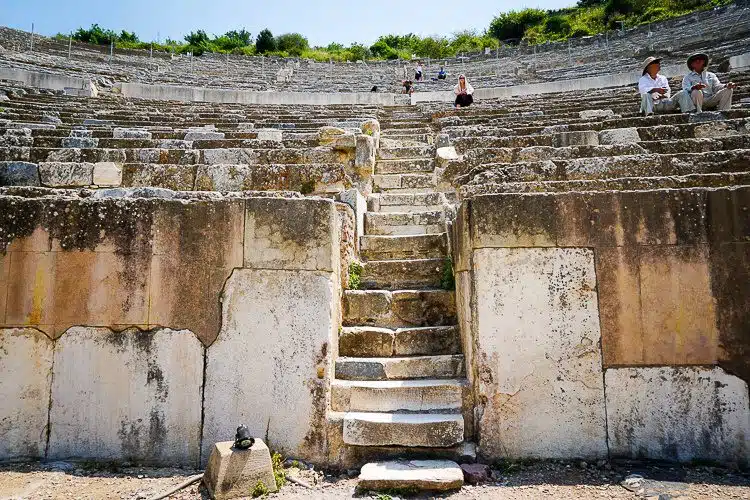
Tips on visiting Ephesus, Turkey:
Woo! That’s a lot of history! So what about the practicalities of visiting? As you might see from these photos, the sun shines powerfully down on the reflective white marble of Ephesus, so for summer touring, do bring a hat or sun umbrella. I would also highly recommend hiring a guide to explain the stories behind the many stones of the city. You might find some locally, though it’s calming to hire a well-reviewed one beforehand.
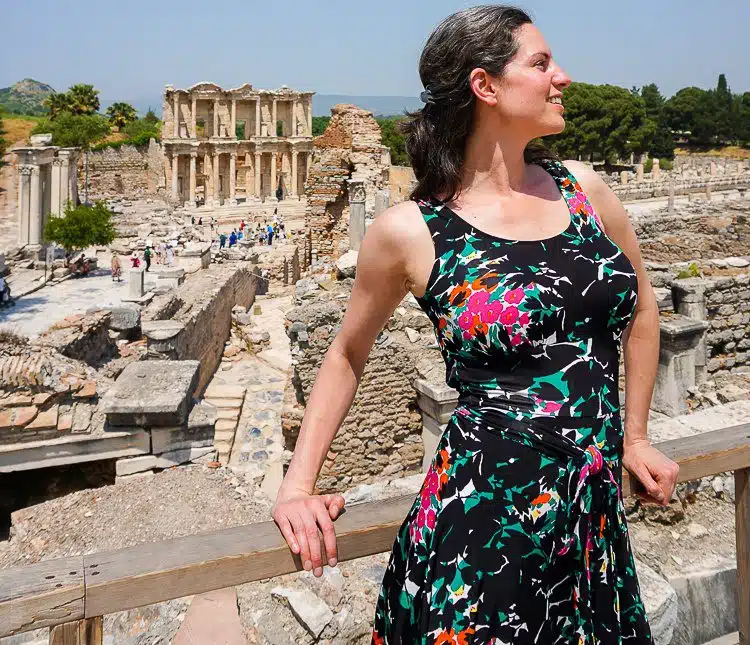
On a side note, if you enjoy the outfit I’m wearing in these photos, check out the full story behind the awesome Leota dress company that my friend from college started. It’s now one of the top women-owned companies in America… and the frocks are the top things I reach for every day in my closet! (See them in action in this movement breaks video.)
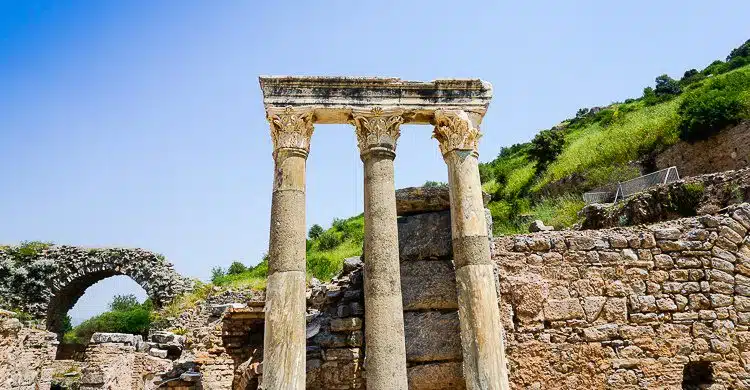
Where to stay when visiting Ephesus:
The closest town to the ruins is Selcuk (click these affiliate links to browse the best-rated Selcuk hotels), though we really loved staying in Kusadasi a few minutes further away so we could be right on the water. Ahh… thinking about that glistening, teal water now!
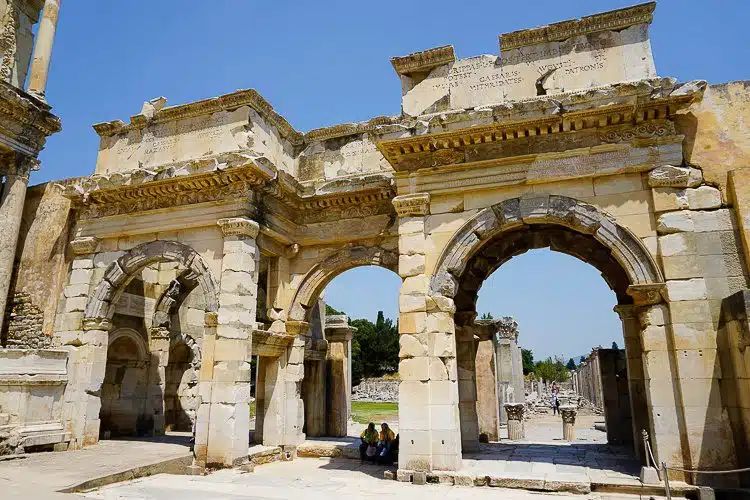
What are your thoughts on Ephesus, Turkey?
Thus concludes our cyber tour of the famed ancient ruins of Ephesus, Turkey. So what do YOU think? Is this a place you have visited? If so, do tell us your experience and insights. If not, does it seem of interest? Comment away!
See more famous architecture and art inspiration from around the world.
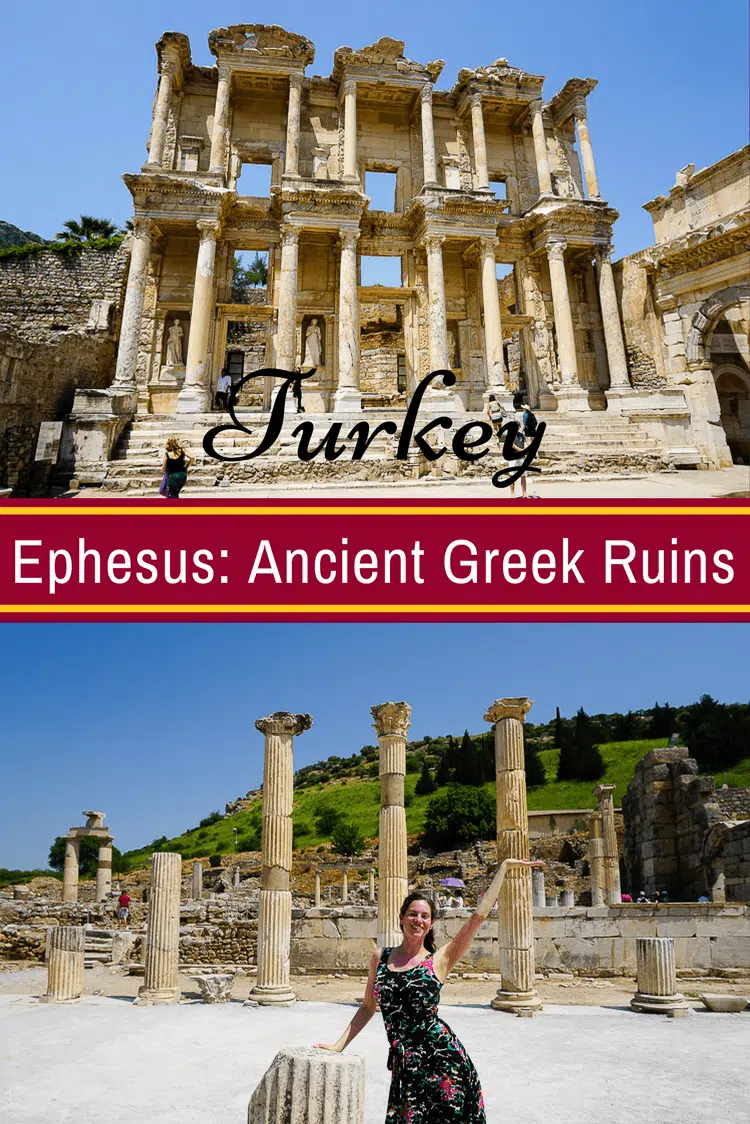
I was a guest of Turkish Airlines for this trip, but all opinions and embraces of ionic columns are my own. This article’s affiliate links support this site at no cost to you. Happy travels!

The author, Lillie Marshall, is a 6-foot-tall National Board Certified Teacher of English, fitness fan, and mother of two who has been a public school educator since 2003. She launched Around the World “L” Travel and Life Blog in 2009, and over 4.2 million readers have now visited this site. Lillie also runs TeachingTraveling.com and DrawingsOf.com. Subscribe to her monthly newsletter, and follow @WorldLillie on social media!

Cobra Lily
Friday 27th of December 2019
Your photos are superb! I could do without the hands upraised in every photo, however the scenery is outstanding. As one reader said, I have not seen such photos anywhere. You capture the largess of the walls.
I wish you had included a photo of Mary's house. I'm amazed at how much traveling you do!
Lillie Marshall
Wednesday 1st of January 2020
Thanks for taking the time to comment and for your kind words about my photos! Here's more information about why I pose the way I do: https://www.aroundtheworldl.com/performativity-female-poses-for-pictures/ .
I actually do have several photos of Mary's house, but there was something about the peacefulness of the place that makes me hesitant to show the pictures. It somehow feels like a violation of the magical privacy of the spot. I do highly recommend visiting it, though!
Elaine
Sunday 27th of August 2017
Thank you for this fabulous information! I'm studying Ephesus, and your photos and descriptions are by far the best I've seen on any website. Well done!
Lillie
Sunday 27th of August 2017
Aww, this comment just made my month, Elaine! THIS is why I blog! Glad to help, and best of luck on your studies.
Duke Vukadinovic
Tuesday 10th of January 2017
I'm so glad you wrote this article, Lillie because Ephesus is one of my favorite places as well!
I was quite skeptical before my first visit but Ephesus is certainly the best-preserved classical city on the Mediterranean. It's even better preserved than ancient Rome itself!
Duke Vukadinovic
Tuesday 17th of January 2017
Couldn't agree more with you on that :)
Lillie
Tuesday 10th of January 2017
Such an important detail that few people know!
Turkey's For Life
Monday 31st of October 2016
It's been a while since we were last at Ephesus but we're hoping to get back early next year to see what else has been excavated since our last visit. Great photos. Real tempters to make sure we return again soon. :) Julia
Lillie
Monday 31st of October 2016
Yes, it's so neat how the ongoing excavation and restoration means every visit is different!
Bama
Saturday 29th of October 2016
Fabulous photos, Lillie! I love how you include the history of Ephesus in the post to give me (and other readers) a brief historical background of the once magnificent city. The ruins still look very impressive today. I can imagine how stately everything would have looked like if nothing were destroyed by humans and nature over the course of centuries. And you're right, some of the best Roman ruins are not in Rome. Leptis Magna in Libya is one of them. Unfortunately the country becomes much safer in the years to come so people can marvel at its exquisite Roman ruins again.